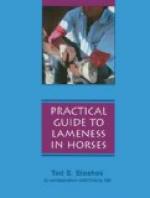From what has been said, it is evident that flexion and extension of stifle and hock are identical in their action. When the stifle is extended, the hock is automatically extended, nor can it under any circumstances flex without the previous flexion of the stifle. There is no parallel to this in the body. The two joints, though far apart, act as one, and they are locked by the drawing up of the patella, and in no other way. The so-called dislocation of the stifle in the horse is a misnomer. That the patella is capable of being dislocated is beyond doubt, but the ordinary condition described under that term, when the stifle and hock are rigid while the foot is turned back with its wall on the ground, is nothing more than spasm of the muscles which keeps the patella drawn up. The moment they relax the previously immovable limb and useless foot have their function restored as if by magic, but are immediately thrown out of gear in the course of a few minutes as a recurrence of the tetanus of the petallar muscle takes place. The fascia of the thigh, like that of the arm, is a most potent factor in giving assistance to the constant strain imposed on the muscles of the limbs during standing.
Below the hock the hind
limb is arranged like that of the fore, the
deep flexor (perforans)
receiving its additional support from the
“check ligament,”
as in the fore leg.
The natural attitude of standing adopted by the horse is to rest on three legs—one hind and two fore. If he is alert, he stands on all four limbs; but if standing in the ordinary manner, he always rests on one hind leg. He does not remain long in this position without changing to the other. Hour by hour he stands, shifting his weight at intervals from one to the other hind leg, and resting its fellow by flexing the hock and standing on the toe. He never spares his fore-limbs in this manner in a state of health, but always stands squarely on them.
Hip Lameness.
Fortunately, because of the heavy musculature which goes to form a part of the locomotive apparatus of the rear extremity, hip lameness is comparatively rare. While the term is in itself ambiguous and signifies nothing more definite than does “shoulder lameness,” yet diagnosis of almost any condition that may be classed under the head of “hip lameness” is not easy except in cases where the cause is obvious, as in wounds of the musculature and certain fractures. To the complexity which the gait of the quadruped contributes, because of its being four-legged, there is added the complicated manner of articulation of the bones of the hind leg. This involves the hip in the manner of diagnostic problems and because of the inaccessibility of certain parts, owing to the bulk of the musculature of these parts, diagnosis of some hip ailments becomes an intricate problem. Consequently, in some instances, before one may arrive at definite and enlightening conclusions, repeated examinations are necessary as well as a knowledge of reliable history and recorded observations of the subject over a considerable period.




